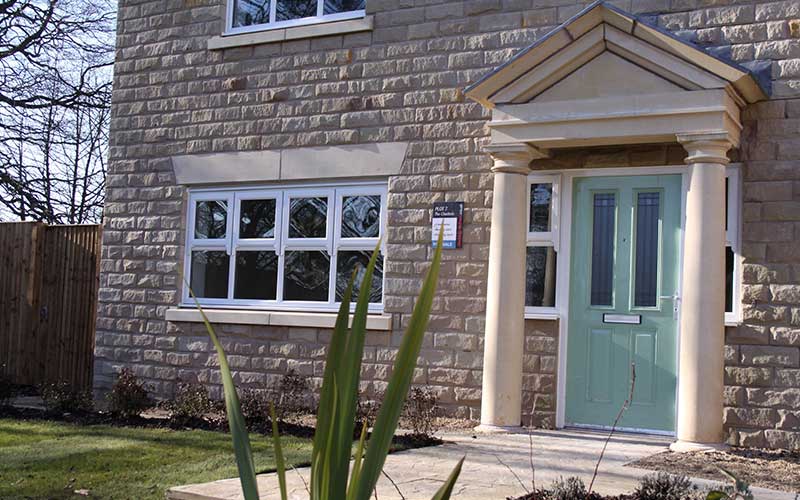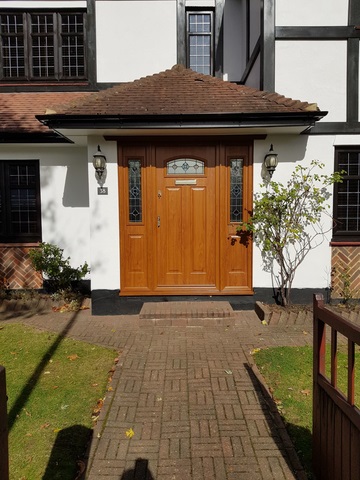
Whether you’re a homeowner residing in a contemporary housing development or a classical rural cottage, you may have found yourself asking the question ‘What are composite doors?’ when seeking a new front entrance replacement. This style of door is one that’s making itself known more and more in today’s market, holding a lot of benefits that vastly improve upon old timber doors and some current uPVC doors.
Because of this, we at Albion Windows thought we’d take the time to set the record straight for those still not in the know about composite doors. Separating the fact from the fiction, here’s our comprehensive guide to what to expect from composite doors in the 21st century!
What are composite doors?
Composite doors take their name from the fact that they aren’t engineered using uPVC or timber, but rather a mixture or ‘composite’ of different materials. This allows them to benefit from the various defensive, heat retentive, and style features found within these separate materials, in theory resulting in a choice of entrance door that truly proves things are stronger together.
Composite doors tend to sport a uniquely classical look despite their ability to deliver U-values as low as 0.8W/m2K – notable for far surpassing modern Building Regulation requirements. This is because most composite door systems are supplied using convincing woodgrain foils on their external panels as the default. This is to maintain the authentic aesthetic present in the classic-style homes they regularly frequent, but this doesn’t mean it’s exclusive.
What are composite doors made of?

This is where things can get a little tricky, considering that there are multiple types of composite door: Those that make use of a timber core and those that boast a polyethylene foam core. Both work well to keep your home defended and comfortable all year-round, but their differences in construction result in some slightly different functions.
Polyethylene composite doors are typically around 40mm thick and are filled with high-density foam core which works to keeps homes well insulated. They are typically finished in an outer skin coating of Glass Reinforced Plastic or “GRP”, a near-invisible layer that helps the composite panels to resist the harshness of certain elements. It’s safe to say with GRP, composite doors will stay looking attractive well into the future.
Timber core composite doors are generally thicker than their polyethylene counterparts, leaning more towards 50mm for extra defence and insulation qualities. Their true timber construction means they are slightly heavier, but this is to their advantage in the form of rigid and trustworthy operation. Some timber composite doors switch GRP for ABS or “Acrylonitrile Butadiene Styrene” skins, being a thermos-plastic layer that is incredibly durable and wholly scratch-resistant.
What do they offer that other doors cannot?

The dense and multi-layered construction of composite doors means allows them to improve upon certain defensive and aesthetic qualities found with uPVC entrance doors. In this manner, composite doors are renowned for their ability to keep precious heat in and unwanted intruders out. Nationwide certifications like PAS24: 2016 and the police-supported Secured by Design are a common presence with composite doors, as is ‘A+’ rated energy efficiency.
On top of this, composite doors are seen as a much more luxury alternative. This is, in part, thanks to their notably intricate construction and more costly materials required. Their unique internal make-up ensures that such problems as warping are made a thing of the past, meaning that gaps will never be at risk of forming around the edge of the door and frame.
What types of property will they suit?
Despite their strong and rigid construction, composite doors are highly flexible in terms of their appearance. This assures that both contemporary and classical property homeowners can take advantage of the many benefits we’ve already covered, all while being able to either retain or reinvent their home’s existing look and feel. That’s to say that composite doors are infinitely customisable.
How long do they last?
Composite doors are notorious in the home improvement industry for their extended shelf life – often up to 35 years. This far exceeds the amount of time any decent performing uPVC front door should be left installed in the home, meaning composite doors represent a greater investment in the long run after the initial cost. Composite doors are much higher in build quality, delivering better performance, and will stay airtight in the frame for years to come.
Is a composite door for me?
Hopefully by now you’ll have a better idea whether or not a composite door would make sense for your budget, lifestyle, and property. They’re often considered one of the most secure and high-performing front entrance options, acting as the luxury alternative to uPVC doors. Complete with various innovative features like outer skin coating, multi-layered construction, and third-party certification, combining classic style with modern performance.
Composite doors are for everybody in this sense, making the question a case of ‘when’ rather than ‘if’. If this guide has helped illuminate some of the lesser-known mysteries regarding composite doors or if you feel like the time is right, contact Albion Windows today. Based in Croydon, we specialise in helping South London homeowners achieve their dream property ambitions.















